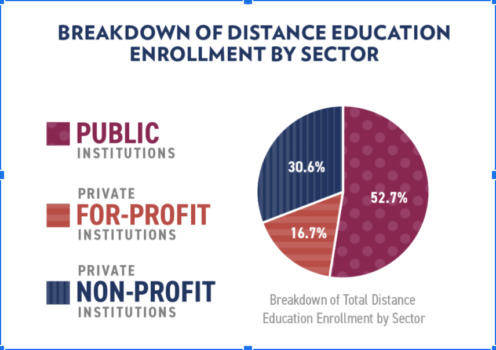The number of students nationwide enrolled in distance education programs rose to nearly 3 million in fall 2019, a 7.5% increase over 2018 enrollment data, according to a new report by the National Council for State Authorization Reciprocity Agreements (NC-SARA). And that’s before the COVID-19 pandemic prompted an unprecedented shift to virtual course delivery.

Source: NC-SARA 2019 Data Report Executive Summary
NC-SARA’s Executive Summary, full report and downloadable data set are available on its website.
Melanie Booth, NC-SARA’s director of educational programs & communications, commented on the merits of having this 2019 distance education data in order to understand the changes that will be reported due to online learning in the wake of COVID-19, noting: “The final glimpse of SARA Distance Education enrollments are pre-COVID (enrollment data is from fall 2019), so we hope that it will serve as a useful baseline to look at enrollment changes coming out of COVID in future years.”
SARA—the State Authorization Reciprocity Agreement—provides a voluntary, regional approach to state authorization of postsecondary distance education. Institutions approved to participate in SARA benefit from a streamlined approach to securing approval to offer distance education/online programming in SARA member states. Participating institutions report enrollment data annually to NC-SARA, illustrating a more complete picture of student location and out-of-state learning activities nationally.
While both in-state and out-of-state distance enrollment grew from 2018 to 2019, more students still enroll in distance education programs offered by institutions in their state of residence. The new NC-SARA data report breaks down the number of students enrolled in distance education by in-state enrollment and out-of-state enrollment as well as by sector and state. In fact 1.6 million students or 54% of all students enrolled in distance learning in state, compared with the 1.3 million or 46% who enrolled in a distance learning programs out of state. One of the most compelling national findings is that in the fall of 2019, public institutions, which made up 51% of reporting institutions, enrolled 53% of in-state distance learners. This indicates that public institutions are important actors in the implementation of distance education, and will continue to be after the coronavirus pandemic.

Source: NC-SARA 2019 Data Report Executive Summary
New England-specific findings
NEBHE serves as the regional coordinating body in eight SARA states: the six New England states of Connecticut, Massachusetts, Maine, New Hampshire, Rhode Island and Vermont, as well as affiliate states New Jersey and New York. In this report cycle, 290 institutions located in the eight states reported 323,752 online students, making up 11% of the national enrollments reported. Approximately 56% of those students enrolled in programs offered by an institution in their state of residence. This shows the importance of in-state online education, even before the coronavirus pandemic.
Consistent with the national trends, the institutions in the NEBHE states saw increases in both in-state and out-of-state distance enrollment. For the complete state by state breakdowns, refer to the charts below.
In the fall of 2019, 170,000 students who lived in SARA participating states outside Connecticut, Maine, Massachusetts, New Hampshire, New Jersey, New York, Rhode Island or Vermont, were enrolled in distance education in the aforementioned NEBHE-SARA states. In the same year, nearly 13,000 students were enrolled in distance education in New England who hailed from non-SARA participating states or territories (California is the last remaining state that is not a member of the agreement). The total number of students enrolled in distance education in New England, New Jersey and New York in the fall of 2019 was 182,641.


Source: NEBHE analysis of NC-SARA 2019 Data Report Executive Summary
* The large representation of New Hampshire students compared with their overall state population is in part because of Southern New Hampshire University (SNHU) a primarily online institution, which enrolls 132,000 online students
Sheridan Miller is coordinator of state policy engagement at NEBHE.
[ssba]
